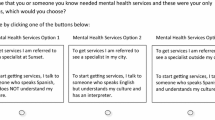Conclusions
This survey involved SBPC, its consumers, and their families in a shared task and work experience which had a direct useful purpose: the planning of the next phase in their collaboration. In this way, the survey, itself, was a vehicle for further cementing the collaborative relationship and was consistent with previous suggestions about promoting consumer and family participation (Church, 1989). Future agency efforts seeking to measure differences in priorities untapped by this survey will involve specific services and situations, such as preference in housing or medication (Uttaro & Mechanic, 1994). Having built the collaboration essential to this work, more complex surveys with refined research selection procedures will be implemented.
Similar content being viewed by others
References
Bernheim, K. (1987). Family consumerism: Coping with the winds of change. In A.B. Hatfield & H.P. Lefley (Eds.),Families of mentally ill: Coping and adaptation (pp. 244–260). New York: Guilford.
Church, K. (1989, June). User involvement in the mental health field in Canada.Canada's Mental Health, 22–25.
Hatfield, A.B. (1987). The National Alliance for the Mentally Ill: The meaning of a movement.International Journal of Mental Health, 15, 79–93.
Lieberman, H.J. (1991). Rehabilitation service needs of clinic patients: A program planning perspective.Administration and Policy in Mental Health, 19, 13–24.
Livingston, J.A., & Srebnick, D. (1991). States' strategies for promoting supported housing for persons with psychiatric disabilities.Hospital & Community Psychiatry, 42, 1116–1119.
Ross, E.C. (Ed.). (1992). Mental health advocacy groups [Special issue].Administration and Policy in Mental Health, 20.
Sarkis, L., Dlugacz, D.P., & Wilner, M. (1987). A unique urban state hospital: Partial-hospital programs reduce full-time bed occupancy.The International Journal of Partial Hospitalization, 4, 157–165.
Sommer, R. (1990). Family advocacy and the mental health system: The recent rise of the Alliance for the Mentally Ill.Psychiatric Quarterly, 61, 205–221.
Uttaro, T., & Mechanic, D. (1994). The NAMI consumer survey: Analysis of unmet needs.Hospital & Community Psychiatry, 45, 372–374.
Van Hoorn, E. (1992). Changes? What changes? The views of the European patients' movement.The International Journal of Social Psychiatry, 38, 30–35.
Author information
Authors and Affiliations
Additional information
The authors are grateful to FUTURE and Caring Community AMI for advice and consultation; Marianna Sarkis and Christianna Sarkis for assistance with data analysis; Joan E. Hanvey for editorial assistance.
Rights and permissions
About this article
Cite this article
Lieberman, H.J., Forbes, J., Uttaro, T. et al. Using needs surveys to foster consumer and family empowerment. Adm Policy Ment Health 23, 357–360 (1996). https://doi.org/10.1007/BF02106813
Issue Date:
DOI: https://doi.org/10.1007/BF02106813




